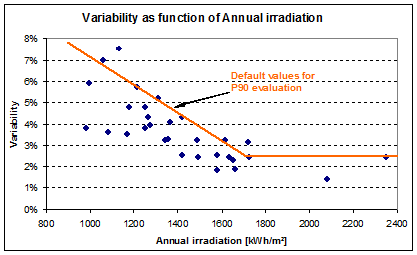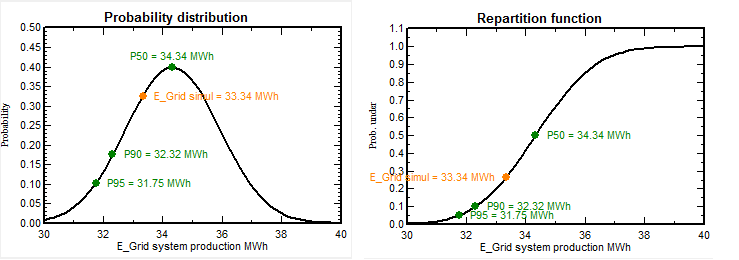-
Posts
2069 -
Joined
-
Last visited
Everything posted by André Mermoud
-
Yes, sorry, I have found another error in this part. Corrected for the next version 6.12, to be released hopefully on 23/09/13.
-
This is (very probably) due to the Project's site definition, which doesn't hold valid monthly values. PVsyst needs monthly values for the sizing tool of the system (the array yield histogram). In the project's definition, please choose a valid project's site (for example in the database). Perhaps the project's file is completely corrupted and unreadable: in this case you have to delete it, and recreate it from scratch. If you give the same project's name, the previous calculation versions of this project will be recovered. NB: This problem arised when explicitely using the tool "Synthetic generation" when defining the project. It has been corrected in the version 6.11, but project's files constructed before V6.11 may be corrupted.
-
The benefits of the ARC are active at not-null incidence angles (for normal beam, if there is a benefit it will be included in the STC specifications). Therefore this should be defined in the IAM behaviour. PVsyst uses a default IAM behaviour (Ashrae parametrization), but allows for the definition of a customized IAM profile. This may be defined either in the module's characteristics, and/or in the "Detailed losses" part.
-
When performing the simulation, the full monthly values of the site should be defined, as some pre-calculations useful for the sizing (like orientation optimization, or inverter sizing) require data of the complete year. Therfore you can simply open the project's site, and ask for importing either Meteonorm or NASA-SSE monthly data. Or choose an existing site in the database for the project's site.
-
I am aestonished, as normally the leap years are treated correctly when importing ASCII files. Please send me your original data file, and the .SIT and .MEF files you have used for importing.
-
This could be treated using the Mismatch loss. I intend to provide a tool for conputing the mismatch on a given array using real modules, which will be suited for such a study, in a rather near future. However if you put all the modules of the same power in a given string, the mismatch in voltage between strings is usually very low. You can evaluate this by using the tool "Electrical behaviour of PV arrays", where you can define 2 strings with different modules, and analyse the Pmpp of the resulting I/V curve. With such a difference (5W/300W = 1.7%), the difference when considering 1 "mean" module of 302.5Wp and 2 strings of 300 and 305 Wp will probably be hardly detectable.
-

2 axis Tracking, problem with simulation
André Mermoud replied to Konstantina's topic in Problems / Bugs
This is indeed a bug which arises in some situations. I have corrected it for the next version 6.12, which should be released hopefully within about one week. -
The variability of the meteo data has been studied, namely by Pierre Ineichen, in a document available from our site (Global Irradiation: average and Typical year, and year-to-year annual variability, University of Geneva, 2011 ). He has collected data from different sources, and analyzed time series of 10 to 30 years for each of the 30 sites studied. The main results are gathered on the plot given below. It appears that the variability is dependent on the annual irradiance: this may be explained by the fact that with sunny climates with many clear days, the possibility of middle or bad days is lower. Therefore for use of these data in theevaluation of the P90 values, we have established an upper estimate which is used as default value. Meteo year-to-year variability, and default estimation for the P90 evaluation
-

What is the reliability and uncertainties of meteo data ?
André Mermoud posted a topic in Meteo data
Commonly available meteo (climatic) data have usually some uncertainties, of different kinds, which may produce very significant differences between sources, or years in a same source. These may be: - The quality of the data recording, care of the operators, positioning, calibration and drift of the sensors, perturbations like shadings, dirt or snow on the sensors, etc. - The fact that many data sources are only available in Monthly values, involving a synthetic generation for getting hourly values, - For terrestrial measurements, the presence of a not negligible horizon, - For terrestrial measurements, the location difference (distance of measuring station), - For Satellite data, the quality of the models used for interpreting the data, which is in continuous improvement since 20 years, and the position of the satellite (if geostationnary), - The yearly variability, which may be supposed to have a gaussian distribution, - The evolution of the climate. In Europe, it seems that the irradiation has increased by as much as 5% or more since the beginning of the 21th century. See the differences in the PVGIS data between the old database and the more recent "Climate-SAF" database. Another example: in Geneva, for official measurements of the ISM, the 2003-2011 average is 10% above the 1980-2002 average ! (which is probably an extreme situation). -

What is the P50-P90 probabilistic production ?
André Mermoud posted a topic in Simulations : results
The P50 - P90 evaluation is a probabilistic approach for the interpretation of the simulation results over several years. This requires several additional parameters, which are not provided by the simulation process, and should be specified (assumed) by the user. From the version 6.11, you can now define P50-P90 estimators with the button "Miscellaneous tools" in the project's dialog. Probability law This approach supposes that over several years of operation, the distribution of the annual yields will follow a statistical law, which is assumed to be the Gaussian (or "normal") distribution. P50-P90 represent different yield levels, for which the probability that the production of a particular year is over this value is 50%, resp. 90%. The problem is now to establish the 2 parameters of this Gaussian distribution, i.e. the Mean value and the Variance (named sigma or RMS). The main contribution to those parameters will be the uncertainty and variability of the meteo data. But other uncertainties in the simulation process and parameters should be taken into account. P50 determination The simulation result is closely related to the Meteo input used for the simulation. This may be of different kinds: - If the data are representative of an average over several years (like monthly averages or TMY), the result should be considered as an average, and corresponds to P50 (mean value of the Gaussian). However PVsyst gives the opportunity of taking a specified climate change into account: this will displace the mean value P50 of the gaussian by respect to the simulation result. This is useful for interpreting simulations performed with old average data (Meteonorm, PVGIS classic, etc), which are known to be lower than the present climate. - If the data are for a specified year, these cannot be considered as representative of the P50 value. In absence of further information you cannot determine a reliable P50-P90 indicator. But if you have some information about the usual average of the site, you can introduce an estimation of the deviation of this particular year by respect to the average. Again, this will displace the P50 value by respect to the simulation result. Variability determination The annual variability (sigma value) will be dominated by the meteo year-to-year variability. Additional uncertainties in the simulation process should also be taken into account: - PV modules model and parameters (the main uncertainty after Meteo) - Inverter efficiency (negligible) - Soiling and module quality loss (highly depending on the site conditions) - Long term degradation - Custom other contributions All these contributions will add quadratically, giving a global variance which may be applied for constructing the final Gaussian distribution function, and give estimation of the P90 or any other Pxx indicator. NB: In the Gaussian distribution, P90 represents a shift of -1.28 sigma, P95 => -1.64 sigmas, and P99 => -2.35 sigmas. Example of a PVsyst P50/P90 determination PVsyst shows a graphical representation of your choices, either as a gaussian probability distribution for several years, or as the corresponding repartition function (the integral of the gaussian). On this example, the simulation was performed using a specific year, which was supposed to be -3% below the yearly average. Therefore the P50 value is higher. A positive climate evolution would have the same effect. In thre program, playing with the uncertainty parameters is highly instructive about the representativity of the simulation result. It is interesting to observe that according to your interpretation of the simulation result (i.e. E_Grid, fixed), the forecats productions distribution may move around your result ! How can I get P90 estimations for monthly or daily values ? If the variations of annual meteo data is of the order of 3-4% (RMS), the variability of monthly data from year to year is much higher, and defining a probability profile for each month will give erratic results. Therefore the P50-P90 statistical estimation doesn't make sense for monthly values. And a fortiory for daily values of course. By the way the probablilty profiles for the determination of P90 are statistical estimations, which should be based on significant weather series (at least 15-20 years of meteo data). For yearly values, in absence of real long-term weather series, PVsyst proposes default RMS values according to very general estimations of some few sites. But we don't avail of such generic data for monthly values, and this would be very dependent on the climate. If you want to do such evaluations, you should find meteo data of 20 years or more for your site, and evaluate the probablity distribution for each month. Correction of Hourly values ? Some people think to simply diminish the yearly hourly results by the ratio of the yearly yields P90 / P50. This is not correct, as the behavior of your system will be exactly the same for a clear day. The eventual P90 "correction" would affect the distribution and frequency of bad weather days, not the absolute yield of each hour. -
Why are you judging that this is an unreallistic yield ? If you don't have shading, soiling, or other losses, and no doubt about the quality of your modules, I don't see any reason. This result is usual for this climate.
-
Yes PVsyst considers one only transformer. If you have several ones, you should adapt the loss parameters accordingly, i.e.: - The "iron loss" is expressed either in percentage of Pnom or in Power. In the first case you should put a weighted average of the Iron losses of each transformer, in the second you should add the power losses. - The "ohmic loss" is expressed in percentage of the PNom at STC. You should put a weighted average of your diffent loss factors. Expressed in terms of resistance, this will correspond to a parallel wiring of all parasitic resistances. Expressed in terms of energy loss, it will be the sum of course.
-
EXCEL doesn't recognize the separator characters by itself. You have to tell him how to import the CSV file. In the "Data" group, choose "Convert" and follow the instructions. This will dispatch the values in their columns. Now a problem may arise with the dates: they are not interpreted by EXCEL in the same way in all countries. Please pay attention of choosing the right format (DD/MM/YYYY in Europe, MM/DD/YYY in the US), when defining the output file.
-

error message while executing Report Command
André Mermoud replied to sairam's topic in Problems / Bugs
This arises sometimes and I don't know why. This is a Windows problem. You can try to download the free tool PDFCreator (to be installed as a printer): http://www.pdfforge.org/products/pdfcreator And choose is as Default printer. To my knowing this works in any case. And after that you can again choose any printer as default ! Mysteries of Windows… -
When exporting a project you shoud use the option "Files" / "Export Projects/Components" in the main menu (your 3rd party designer should have done this). This ensures that all files involved in the project (i.e. .PRJ, *.VCi, .MET file, and components file if they are custom defined) are indeed present. And you can import this project using "Files" / "Export Projects/Components".
-
The number of sehds is the number of rows. It is useful for the shading factor calculation, as the first shed is not shaded. The shading limit angle is the limit profile angle, which just begins to produce shades on the next shed (row). It is shown in yellow on the Unlimited sheds definition panel. The "Profile angle" is the angle of the plane passing by the basis of your sheds and the sun, and the horizontal plane. There is no minimum for the limit shading angle: it is your choice. However, people usually choose it so that there is no shades in December 21th at 12:00.
-
This option of electrical shading calculation is only useable when you fully define the "Module layout" parameters. If you have not done this, the message is indeed empty by mistake. I have filled it for the next version 6.12.
-
Yes, the format of the PHOTON modules page has changed on 06/09/13. I had to update the importing tool accordingly. This will be OK in the next versions 6.12 and 5.71, available before the end of September.
-
In the version 5, the default transposition model was the Hay model. In the version 6, the default has been changed to the Perez model, as according a recent study it appears as slightly better. See in the FAQ, the differences in yield between the version 6 and the version 5.
-
It has perhaps been removed by mistake, I don't know. I will reintroduce it for a next version.
-

Empty "Warning" message in Near Shading Definition
André Mermoud replied to azein's topic in Problems / Bugs
This option is to be used when you define a "Module Layout" configuration. If such a configuration is not defined, there is nothing to calculate, and this option should not be activated. It is indeed a mistake in the present version, I will manage for desabling this option. -
You can simply try it by yourself, using PVsyst... And tell us your conclusions if you have interesting ones.
-
It is not possible directly in PVsyst (and probably in any other software). PVsyst is based on the Diffuse part. The DNI is computed in hourly values from the global and the diffuse. The DNI is defined on a monthly basis only as a sum of these hourly values. Now the generation of hourly values is performed using the synthetic generation model. This complex model is based on the Horizontal global (and possibly the specified Diffuse). We don't have any model for generating hourly values from monthly DNI data.
-

How to change my Helioclim data to the standard PVsyst format
André Mermoud replied to Konstantina's topic in How-to
The direct import of the helioclim3 monthly data is not implemented in PVsyst in the present time. Some years ago Helioclim proposed monthly data (HC1) for several years, and I had developed the importing tool for these data. But the data format has changed with the new version HC3, and I did not yet write the updated tool in PVsyst. However you can easily create a "Site" in PVsyst using these monthly data: please use "Database" / "Geographical sites" / "New", and fill all the required fields in the dialog. You can directly "Copy" the 12 monthly values of the Global Horizontal (or temperature) from your ECXCEL file. The simulation requires at least the Global Horizontal and Ambient temperature data. All other values are optional. -

Simulation Results - winter & summer time ?
André Mermoud replied to CarolineL's topic in Simulations
The winter/summer time (named DST - Daily Saving Time in the US) affects the simulation during the year. It doesn't have any impact on the simulation results. Except for the financial revenues if you have specific tariffs for specific legal hours: in this case you have to do your financial balance by yourself (in EXCEL), using the CSV hourly output file. The DST is in principle defined in the Meteo data file. However PVsyst (as many solar software and meteo data sources) doesn't take it into account, and renormalizes all the data in the same time (usually the winter time). When you import an external meteo file which takes the DST into account, PVsyst corrects the values for getting homogeneous time definitions along the year.



